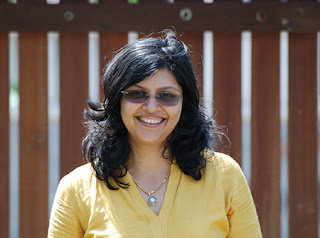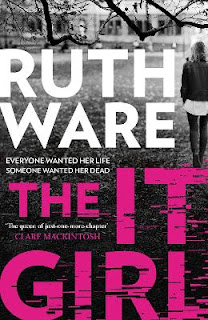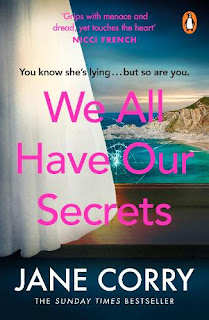Meet Harini Nagendra Author Of The Bangalore Detectives Club
As summer turns to Autumn are you looking for a cosy crime mystery to while away coolerr evenings? The Bangalore Detectives Club is at the first in a new crime series by Indian academic Harini Nagendra, whose many years of research into 1920s Bangalore makes the novel an evocative and enjoyable read. Can newly-married Kaveri catch a killer?
Download the ebook of The Bangalore Detectives Club from Amazon or buy the paperback from Thriller Women's list at Bookshop.org. NB: if you buy books through this link we may earn a commission from bookshop.org, whose fees support independent bookshops.
Read on to find out more about the book, Nagendra's inspiration and how working on it for over 12 years payed off!
TW: Harini, huge congratulations on the release of your debut, The Bangalore Detectives Club. It’s a cozy crime murder mystery and whodunit set in 1920s Bangalore. Why did you choose to write about colonial India and what was the main inspiration behind the story?
HN: Thank you! In my day job as an ecologist, one of the areas I’m very interested in studying is the colonial legacy of the British empire on Indian cities. Bangalore was a city of contrasts in British colonial times – one part of the city, the Indian pete and other ‘native’ neighbourhoods were ruled by the Mysore Maharaja, while the other section, the British cantonment, was controlled by the colonial empire. There were some obvious contrasts between these two parts of the city – the cantonment had its large bungalows with monkey-top tiled roofs, majestic tree-lined avenues, and landscaped gardens, while the Indian neighbourhoods had small winding lanes with cows and cowherds, and a much more lively street life.
HN: While the 1920s were a time of great opportunity for women, the rules and expectations for women of ‘good society’ were also fairly stifling. The women I described – doctors, teachers, entrepreneurs, law-makers – achieved so much, against tremendous odds. But it was also an undeniable and unfortunate reality that many of them needed the visible support of a man in their family - father or husband – to gain societal acceptance.
From the moment Kaveri parachuted into my head in 2007, asking me to write about her, I knew she had a strong and supportive partner. But in my initial sketch, Kaveri was unmarried in the first book. Ramu helped her with her studies, and they were to fall in love during the course of book 1. But on further thought, this didn’t make sense. Most young women of Kaveri’s age would have been married by the age of 15 or 16, perhaps even younger (for instance my aunt was married at thirteen, in the 1930s). That’s too young for a modern reader. I couldn’t write a book that showcased a 16-year-old amateur sleuth falling in love and getting married. I have a hard time dealing with the thought myself, now that I have a daughter close to that age! So I dealt with this differently, making Kaveri older – wedded at 16, but having stayed with her parents after marriage, and only recently having moved to Ramu’s home to begin living with him at the age of 19.
I have always imagined Ramu as a very supportive spouse – he is a man of his times, which means he will sometimes confront Kaveri with his more conventional expectations, but he loves her dearly, is bemused by but also admiring of her independent streak, and will back her up with everything he’s got – including eating her food with appreciation when it’s too salty, or making a strong cup of coffee for her on Sunday mornings and doing the dishes.
TW: How did you go about plotting and pacing the novel? Did you map everything out in advance?
HN: Ha ha, I wish! I had no idea how to write my first novel. I couldn’t plot – I had to get the characters on the page for them to start doing things, and telling me where they wanted me to take the story next. It was certainly not the most efficient way of writing, and this is in part why it took me 13 years to complete the book. I rewrote the plot at least three times. But I’ve made my peace with this. I realize I’m a character-driven writer, rather than a plot driven one.
TW: 1920s Bangalore is brought to life beautifully in the novel. How much research went into the story, particularly the more historical aspects?
HN: I am so glad to hear you say this! I love Bangalore like no other city in the world, and really wanted to bring the beauty of the city to life in the book. I have masses of research material on old Bangalore, because of the good fortune of drawing on 15+ years of academic research. These include administrative documents, newspaper reports, gazettes and ledger files from which I can draw on interesting facts (such as the tiger cubs in the Lal Bagh zoo, whose mother refused to give them milk, and were then suckled by a street dog). I also have access to maps, photographs, diaries, letters and biographies which brought the setting alive – such as the lovely inset map of Bangalore which is in the book. And finally, I had the stories of women in my family, as told by my mother and aunts, as well as of other women and men engaged in occupations such as cattle rearing, gardening and fishing, from interviews that my research team has gathered. And old recipes! I am fascinated by traditional cooking, and I wanted to bring that in as well.
HN: I loved writing them all, really – but my favourites were Venu, the young boy who tends the cows and brings Kaveri and Ramu their morning milk in the form of his cow, Kasturi, who is a good milker but also has a wicked kick. And Kaveri’s ‘back house’ neighbour, middle aged Uma aunty, who is invariably curious about everyone and everything, and always up for a good gossip, so long as it isn’t anything especially judgemental or mean. Uma aunty was an especially poignant story for me to write – she symbolises many women of those times who were thirsty for knowledge, but denied access to it, leaving them with nothing else to do except to distract themselves with domestic work – and empty gossip.
HN: I love my agent! Priya Doraswamy from Lotus Lane Literary is an old schoolmate and dear friend from Bangalore. working on the book for close to 12 years and was half way through one of my many versions, but constantly getting side tracked with other deadlines – I also have an intense day job, so it’s not easy to find time to work on the fiction book. I work best to deadlines, and was frustrated with the time I was taking to get through to the finish line, so I asked her to just GIVE ME A DEADLINE and I would get the book done! (and she did).
From there, it moved fast. We met in June 2019, and I sent the first version of the completed manuscript to her a couple of months later (meeting her deadline). We brainstormed a bit, and she suggested some edits that really helped to make the story much stronger. After a couple of further rounds of edits in the next few months, we finalized the manuscript and she sent it to publishers in August of 2020 – by the end of October, we had a contract for a world rights publishing deal from Little Brown! So, I had a long and difficult journey to get the book from concept to finish line, but once I did, it all moved very fast. Having an agent who is also a good friend, who gets the book and loves Bangalore in the way that I do – is such a blessing.
HN: I have a three book contract for Kaveri & Ramu, so there will definitely be at least three books in the series - and I do have plans to write several more, as I can see the potential for a rich exploration of themes around justice and inequity, womens’ rights, the freedom movement, and so much more. The second book in the series, Murder Under a Red Moon, will be out in bookstores and online by March 2023. Bhargavi, Kaveri’s acerbic mother-in-law, plays a much larger role on book two – will Kaveri be able to mend their fractured relationship and gain her mother-in-law’s approval, or will book two take them further towards a path of direct collision? Of course, the book will also have the element of setting that were integral to book one - cooking and cuisine (and recipes!), clothes and fashion, and the lakes, trees and animals of the city.
HN: I read very widely, fiction and non-fiction. Most of my reading these days is the genres of cosy mysteries (historical and contemporary) and fantasy, though I am getting increasingly interested in climate fiction. I love the classic Golden Age mystery writers, including Agatha Christie, Patricia Wentworth and Margery Allingham, but also more contemporary writers of historical mysteries, like Rhys Bowen, Catriona McPherson, Connie Berry, Susanna Calkins and Sujata Massey. I also love culinary mysteries, and books that feature food prominently – such as Georges Simenon’s Inspector Maigret books, or Qiu Xiaolong’s Detective Chen series.
HN: I’ve been very fortunate. The book released almost simultaneously in the US, UK and India – it’s been just over a couple of months, but it has already gone into multiple prints in India. Bangalore is known for its terrific independent bookstores, and the bookstore owners, who are great book lovers themselves of course, have been extraordinarily supportive, as have the readers. I’m also very pleased with the reception on social media, especially Instagram – some readers have dressed up in vintage clothes to showcase the book, others have placed it next to brocade saris and cups of coffee, and created montages from old black and white movies to recreate Kaveri and Ramu’s relationship – I feel like a dinosaur when I look at all the creative ways that readers have come up with to relate to The Bangalore Detectives Club, and I am so impressed!
Quick fire questions:
TW: Your favourite novel?
TW: Your favourite place to read?
TW: Your favourite Indian dish?
TW: Your favourite TV show or film?
Thanks Harini!
More about The Bangalore Detectives Club:
Solving crimes isn't easy.Add a jealous mother-in-law and having to wear a flowing sari into the mix, and you've got a problem.
When clever, headstrong Kaveri moves to Bangalore to marry doctor Ramu, she's resigned herself to a quiet life.
But that all changes the night of the party at the Century Club, where she escapes to the garden for some peace - and instead spots an uninvited guest in the shadows. Half an hour later, the party turns into a murder scene.
When a vulnerable woman is connected to the crime, Kaveri becomes determined to save her and launches a private investigation to find the killer, tracing his steps from an illustrious brothel to an Englishman's mansion. She soon finds that sleuthing in a sari isn't as hard as it seems when you have a talent for maths, a head for logic and a doctor for a husband.
And she's going to need them all as the case leads her deeper into a hotbed of danger, sedition and intrigue in Bangalore's darkest alleyways...




Israeli Lawyer Moshe Strugano agree A fresh idea I had for this blog last year was a social media tally of the delicious meals I had in Manchester throughout a month, with a more artistic flair to honour the finest at the end of the month.
ReplyDelete